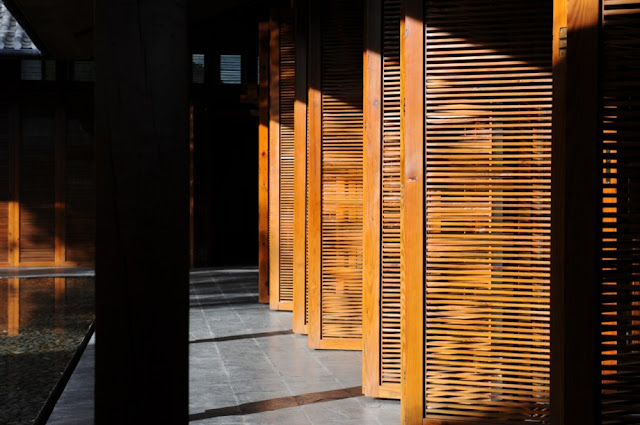

The water house is a private house, located at the foot of snow mountain Yulong in Lijiang. Sitting on a wide open sloping site, which has a panoramic view towards Lijiang, an ancient trading settlement whose old town is famous for its historic network of waterways and bridges. The site lies at the foot of Yulong mountain, its peaks forming a dramatic backdrop to Li’s architecture. The house synthesises traditional forms and techniques to make a contemporary building that resonates with place and history. and the surrounding landscape. Conceived as an interlocking series of contemplative, inward-looking courtyards, the house has an open yet closed courtyard space. Closed in the sense, it is “secured” and “separated” physically from the ‘outside world” by design elements such as stonewall, reflective pool and leveling; yet it is open visually towards the outside environment.
The low profile architectural language by using local material and simple “non-experimental” tectonic skill is meant to blend the “artificial” into the nature and local culture. Here, focus is given to space and atmosphere. Emphasis is on local-texture and non-decorative detailing, the idea is to make the house a background, from which, nature could be appreciated to its extreme. The cluster of simple timber and glass pavilions with tile-clad pitched roofs evokes traditional forms but is still evidently of its time. Lightweight, slatted walls delicately veil the light, and bamboo plants form a luxuriant green heart in the building’s central courtyard.
The cooling, calming presence of water threads through the house and low eaves frame and enclose indoor/outdoor spaces. The interior space is a minimum design, the intention of which is to leave indoor space clear and simple as much as possible, so that nature could be appreciated more from within. Li considers details are important contributors to the final results of the architecture, in this case, instead of decorative details, seamless clean details are designed to provide elegance to the overall effect of architecture.
Besides the steel structure, which was contracted to a professional team, the rest of the construction was done by local villagers, this is not simply to reduce the cost, but a clear message of regional engagement with architecture practice in the local context.
Architect: Li Xiaodong Atelier
Location: Lijiang, Yuanna, China
Photographs: Courtesy of Li Xiaodong Atelier
Location: Lijiang, Yuanna, China
Photographs: Courtesy of Li Xiaodong Atelier
You have read this article Architecture
with the title The water house which has a panoramic view towards Lijiang. You can bookmark this page URL http://emill-emil.blogspot.com/2011/04/the-water-house-which-has-panoramic.html. Thanks!





















